In the late summer of 2018, RTÉ 2 aired the Australian set period drama Picnic at Hanging Rock. An adaptation of Joan Lindsay’s 1967 novel of the same name, the six-part series tells the story of the disappearance of three schoolgirls and their teacher in 1900 Australia. This is the second major screen adaptation of Lindsay’s novel, after Peter Weir’s celebrated 1975 film. The series as a whole is imbued with a sense of mystery and foreboding, exploring themes such as repressed sexuality, female conflict and friendship, physical and psychological abuse, the supernatural, colonialism and identity.
In the next two articles, I will be looking at how the series portrays the way that a young woman’s identity and value is shaped by expectations around personal appearance and conduct. I will explore how the school’s motto, “Purity and refinement, the Appleyard promise,” exemplifies the pressures and restraints faced by the young women at the centre of this series. In this article I will look at the role of costume in the series, focusing on the importance of clothing in shaping an individuals identity and the role that it plays in establishing a characters ambitions, personality and personal restrictions.
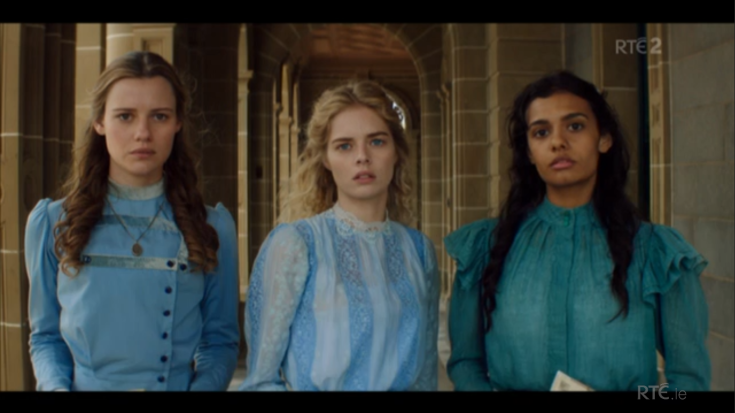
In the previous article, entitled “Colonialism and escape in the Australian wilderness,” I looked at how the character of Hester underwent a personal transformation when she fled to Australia. Her voiceover in Episode One draws attention to the importance of clothing in forming an individuals identity:
“Arthur’s right. People always believe their own eyes. Dress like a tart, you’re a tart. Dress like a widow…”
Hester recognises how easily people can be fooled by a person’s outward appearance. Despite growing up surrounded by poverty and crime, she can fool members of the Australian gentry that she is a born and bred member of the upper classes by maintaining the outward appearance of an elegant, well-dressed lady.
When the audience first sees Hester, she is dressed entirely in black, with her tailored dress and elegant veil creating the image of a respectable, wealthy widow. Hester uses clothing as a tool to help her integrate into the upper-class society around her. Her outward appearance is carefully maintained, and she always appears impeccably dressed. Her use of strong colours and luxurious fabrics creates the image of her as both ladylike and powerful. In an interesting choice by the series’ costume department, Hester often wears colours and fabrics that have a distinctly oriental flare. This is perhaps a reference to the British Empires domination over parts of Asia during this period. She is frequently seen in silks, and her colour palette often includes vivid yellows, reds and purples.
Hester’s student Irma Leopold also recognises the importance of clothing in shaping how an individual is perceived by the world. As a wealthy English heiress, Irma has been raised to believe that her value is largely determined by her outward appearance. When we are first introduced to Irma, she is inspecting her wardrobe, preoccupied with finding an outfit to wear on a school outing. Irma pays careful attention to her appearance and stands out among the other students at Appleyard College with her bright, elaborate outfits and immaculate appearance. Irma is someone who has become accustomed to being admired for her beauty, and her pristine appearance and wealth has given her an elevated position at the school. After receiving the most Valentine’s Day cards, she is given the honour of cutting the cake at the school’s picnic, proving the value that this society places on young women appearing attractive to men. Out of the older girls at the school, Irma is the one most preoccupied with finding a husband. As a wealthy young heiress, she is aware that she is seen as an attractive prize to members of the local elite. Irma is a character who sees her life goal as attracting a suitable husband, and she craves romance and male attention. Her outfits are carefully chosen to allow her to appear both alluring and demure. She is frequently seen dressed in shades of pink, demonstrating her romantic nature.
However, as the series progresses, we become aware that Irma’s pristine outward appearance is masking her deep-seated insecurities. Despite seeming outwardly confident and self-possessed, Irma is shown to be a vulnerable young woman who lacks any secure sense of self. Like Hester, she uses her clothing to construct her identity and bolster her sense of self. She craves the security and comfort of marriage, and will happily alter her identity to secure a husband. This is revealed during her brief relationship with Michael Fitzhubert. Despite her love of fashion and expensive jewellery, Irma is willing to completely transform her outer appearance to appeal to him. Believing that Mike is attracted to “pure and simple” girls, Irma chooses to cast off her valuables to conform to what she believes is his idea of a perfect wife. She gives away some of her expensive jewellery to her teacher Dianne, stating that “they’re all just baubles really. They have no real importance.”
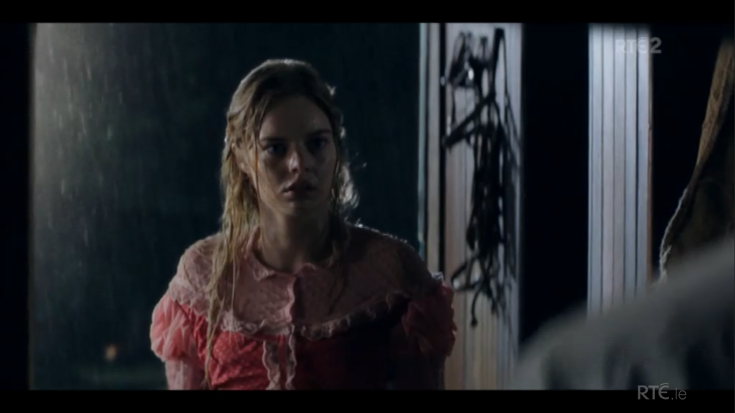
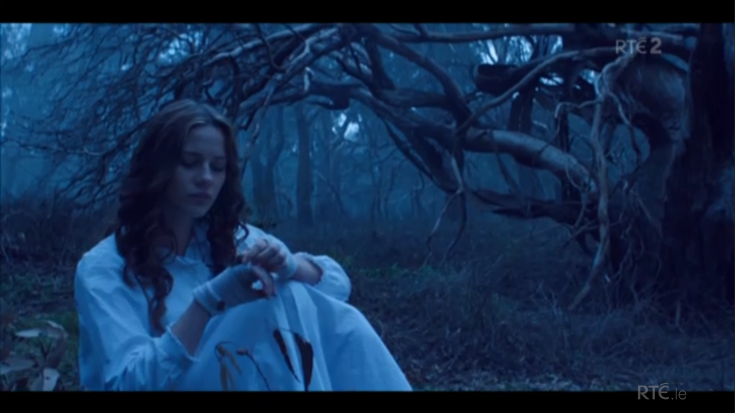
“I don’t want to be elegant. I’m not a horse being groomed for auction like you.”
Episode 6 features a flashback showing Miranda’s visit to her family farm before her disappearance. While staying with her family, Miranda expresses her unhappiness at the school and her wish to remain at home. Miranda associates the farm with freedom while her life at Appleyard College is seen as a prison-like existence.
In an interview with The New York Times, Larysa Kondracki, who served as a director and showrunner for the series, highlights how the costumes aren’t merely decoration but serve as “an extended symbol of the societal oppression women faced during the Victorian era.” Kondracki goes on to explain the role of clothing in showing the restricts faced by the girls in their daily lives:
“the whole thing is about repression… These girls have to dress themselves up to constrain themselves into a form that was expected of them” (Safronova, New York Times).
In period films and television, series corsets are often used as visual codes for female oppression, as corsets are used to bind and shape the female body into an aesthetically pleasing form. In an act of rebellion, Miranda places her corsets on display on top of a fence. Her mother is furious at her for this, reminding Miranda of how much money the family invested in her school clothes. After this confrontation, we see Miranda being laced into her corset by her mother, with an expression of agitation and uneasiness clearly visible on her face. Later when Irma, Marion and Miranda have escaped to the top of the Hanging Rock, they throw their corsets off the rock’s edge in an expression of freedom and defiance.
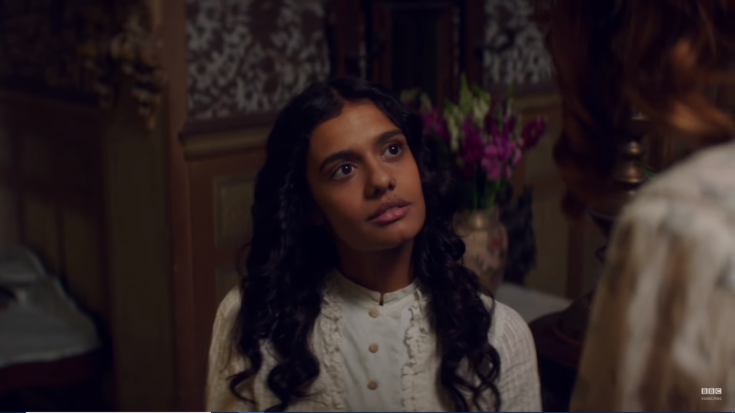
In Peter Weir’s 1975 adaptation of Picnic at Hanging Rock, the white dresses worn by the girls to the picnic became an iconic piece of costume design associated with the film. In this new adaptation, the costume department decided to recreate this design choice. In an interview with The New York Times, costume designer Edie Kurzer explains the reason behind this design choice explaining that:
“The white dresses are very much a look from Victorian times. We asked ourselves, ‘Are we going to take any artistic license or are we going to stick with the iconic picnic dresses?’ It seemed obvious that we had to stick with what was of the time, of the period” (Safronova, The New York Times).
The white dresses highlight the value placed on purity within the school. Dressing the girls in white is used to evoke a sense of pure, virginal beauty. Within the local community, the girls are objects of fascination and attract attention wherever they go. While on their way to the picnic, they travel through the town where they attract the gaze of everyone they pass. Hester and the school’s teachers are aware of this. While the girls are allowed to remove their gloves for the day, they are only permitted to do this once they have passed through the town, ensuring that they don’t allow their pristine appearance to slip in front of the locals. Hester also shows her preoccupation with how the girls appear in public when she inspects their attire before they attend a fete at the governor’s house.
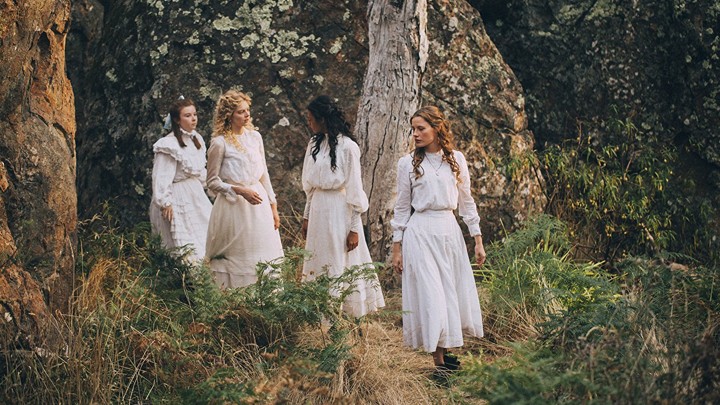
In Picnic at Hanging Rock, clothing is used as a way to construct a character’s identity. The way the girls dress demonstrates not only their sense of self and personal ambitions but also the school’s and society’s expectations of them. Given the restrictive nature of women’s clothing during this time, it is clear that there is a connection between the female characters clothing and the oppression that they face in their daily lives.
Works Cited
Bass, Trystan L. “Picnic at Hanging Rock (2018).” Frock Flicks, 26 June 2018. http://www.frockflicks.com/picnic-at-hanging-rock-2018/. Accessed 6 October 2018.
Safronova, Valeriya “Costume Secrets From ‘Picnic at Hanging Rock’.” The New York Times, 29 May 2018. https://www.nytimes.com/2018/05/29/style/amazon-picnic-hanging-rock.html. Accessed 9 October 2018.
Credit for cover photo to rte.ie.
Other images to frockflicks.com, imdb.com, express.co.uk, radiotimes.com, rte.ie, pinterest.ie, frasercoastchronicle.com.au, farfarawaysite.com, bbc.co.uk.
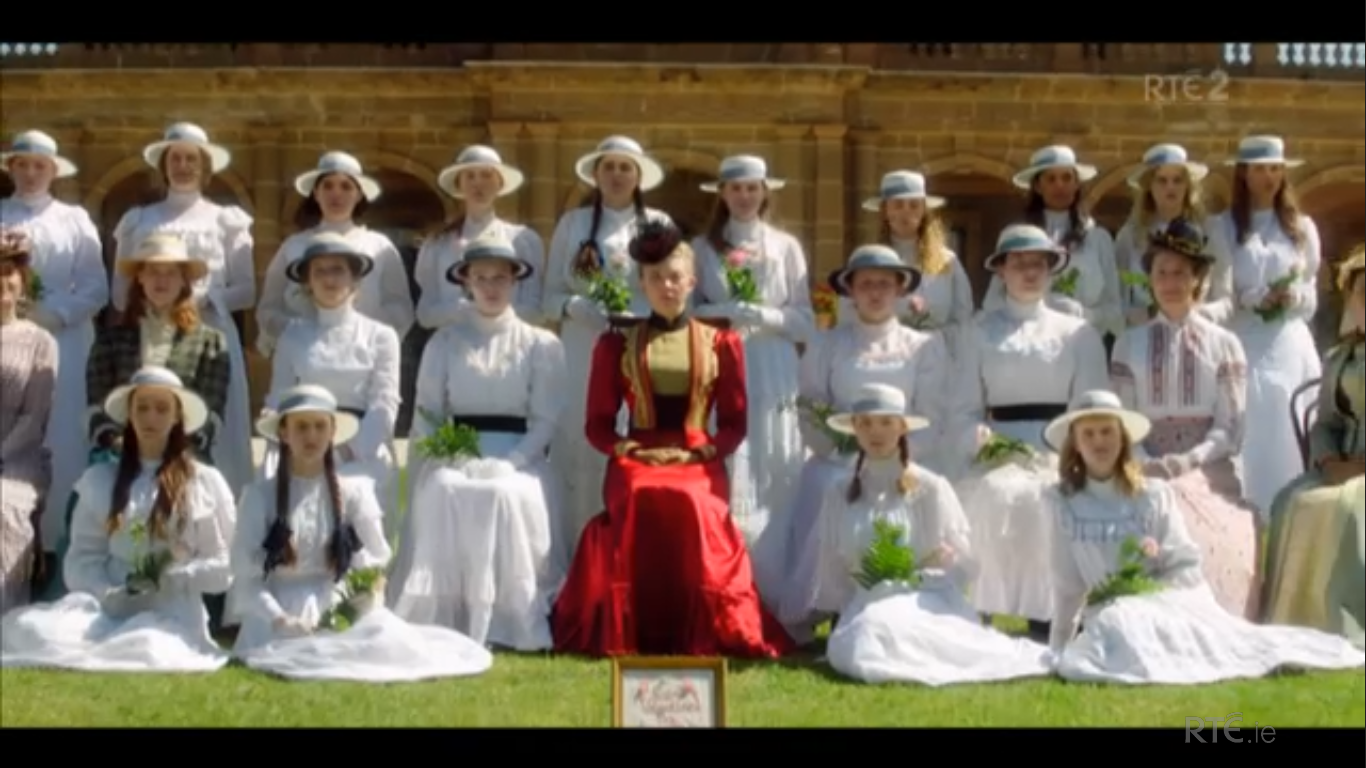
![picnichangingrk-2018-appleyard-mourning1 [Image: frockflicks.com]](https://scealmilis.files.wordpress.com/2018/09/picnichangingrk-2018-appleyard-mourning11.jpg?w=399&resize=399%2C266&h=266#038;h=266)
![download (1) [Image: frasercoastchronicle.com.au]](https://scealmilis.files.wordpress.com/2018/09/download-1.jpg?w=399&resize=399%2C224&h=224#038;h=224)
![picnichangingrk-2018-appleyard-green1 [Image: frockflicks.com]](https://scealmilis.files.wordpress.com/2018/09/picnichangingrk-2018-appleyard-green11.jpg?w=329&resize=329%2C494&h=494#038;h=494)
![eadd0d4c3be2344e69a15836ef9a5159 [Image: pinterest.ie]](https://scealmilis.files.wordpress.com/2018/09/eadd0d4c3be2344e69a15836ef9a5159.jpg?w=381&resize=381%2C231&h=231#038;h=231)
![Generic [Image: radiotimes.com]](https://scealmilis.files.wordpress.com/2018/09/natalie-dormer-plays-hester-appleyard-in-picnic-at-hanging-rock-5ae4ff7.jpg?w=381&resize=381%2C285&h=285#038;h=285)
![picnichangingrk-2018-appleyard-sleeveless [Image: frockflicks.com]](https://scealmilis.files.wordpress.com/2018/09/picnichangingrk-2018-appleyard-sleeveless.jpg?w=347&resize=347%2C520&h=520#038;h=520)
![picnichangingrk-2018-irma-white-blouse-bluedot-skirt [Image: frockflicks.com]](https://scealmilis.files.wordpress.com/2018/09/picnichangingrk-2018-irma-white-blouse-bluedot-skirt.jpg?w=232&resize=232%2C348&h=348#038;h=348)
![getimage [Image: express.co.uk]](https://scealmilis.files.wordpress.com/2018/09/getimage.jpg?w=246&resize=246%2C348&h=348#038;h=348)
![picnichangingrk-2018-irma-pinksuit-cape [Image: frockflicks.com]](https://scealmilis.files.wordpress.com/2018/09/picnichangingrk-2018-irma-pinksuit-cape.jpg?w=246&resize=246%2C348&h=348#038;h=348)
![Screenshot (202) [Image: rte.ie]](https://scealmilis.files.wordpress.com/2018/09/screenshot-202.png?w=241&resize=241%2C241&h=241#038;h=241&crop=1)
![Screenshot (203) [Image: rte.ie]](https://scealmilis.files.wordpress.com/2018/09/screenshot-203.png?w=241&resize=241%2C241&h=241#038;h=241&crop=1)
![Screenshot (153) [Image: rte.ie]](https://scealmilis.files.wordpress.com/2018/09/screenshot-153.png?w=241&resize=241%2C241&h=241#038;h=241&crop=1)
![MV5BMTZhZTcxODYtOGZiZC00OTY2LTk4NGQtYWQ3NjNjN2E2NGQ4XkEyXkFqcGdeQXVyMTExNDQ2MTI@._V1_SX1777_CR0,0,1777,999_AL_ [Image: bbc.co.uk]](https://scealmilis.files.wordpress.com/2018/09/mv5bmtzhztcxodytogzizc00oty2ltk4ngqtywq3njnjn2e2ngq4xkeyxkfqcgdeqxvymtexndq2mti-_v1_sx1777_cr001777999_al_.jpg?w=241&resize=241%2C241&h=241#038;h=241&crop=1)
![Screenshot (213) [Image: bbc.co.uk]](https://scealmilis.files.wordpress.com/2018/10/screenshot-213.png?w=241&resize=241%2C241&h=241#038;h=241&crop=1)
![28 [Image: farfaraway.com]](https://scealmilis.files.wordpress.com/2018/10/28.jpg?w=241&resize=241%2C241&h=241#038;h=241&crop=1)
Leave a comment